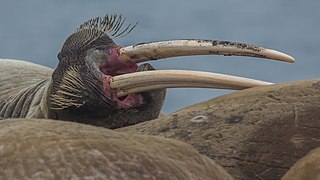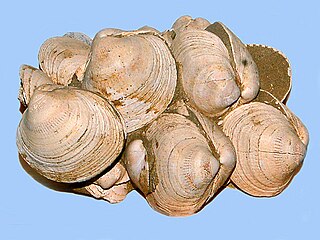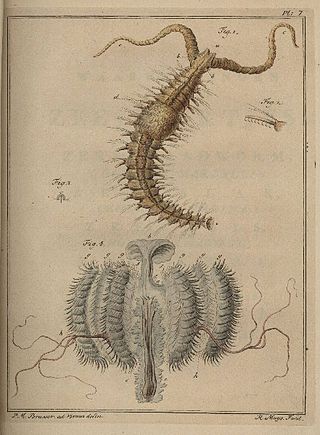
Polychaeta is a paraphyletic class of generally marine annelid worms, commonly called bristle worms or polychaetes. Each body segment has a pair of fleshy protrusions called parapodia that bear many bristles, called chaetae, which are made of chitin. More than 10,000 species are described in this class. Common representatives include the lugworm and the sandworm or clam worm Alitta.

Bivalvia, in previous centuries referred to as the Lamellibranchiata and Pelecypoda, is a class of marine and freshwater molluscs that have laterally compressed bodies enclosed by a shell consisting of two hinged parts. As a group, bivalves have no head and they lack some usual molluscan organs, like the radula and the odontophore. The class includes the clams, oysters, cockles, mussels, scallops, and numerous other families that live in saltwater, as well as a number of families that live in freshwater. The majority are filter feeders. The gills have evolved into ctenidia, specialised organs for feeding and breathing. Most bivalves bury themselves in sediment, where they are relatively safe from predation. Others lie on the sea floor or attach themselves to rocks or other hard surfaces. Some bivalves, such as the scallops and file shells, can swim. Shipworms bore into wood, clay, or stone and live inside these substances.

A cold seep is an area of the ocean floor where hydrogen sulfide, methane and other hydrocarbon-rich fluid seepage occurs, often in the form of a brine pool. Cold does not mean that the temperature of the seepage is lower than that of the surrounding sea water. On the contrary, its temperature is often slightly higher. The "cold" is relative to the very warm conditions of a hydrothermal vent. Cold seeps constitute a biome supporting several endemic species.

Bioturbation is defined as the reworking of soils and sediments by animals or plants. It includes burrowing, ingestion, and defecation of sediment grains. Bioturbating activities have a profound effect on the environment and are thought to be a primary driver of biodiversity. The formal study of bioturbation began in the 1800s by Charles Darwin experimenting in his garden. The disruption of aquatic sediments and terrestrial soils through bioturbating activities provides significant ecosystem services. These include the alteration of nutrients in aquatic sediment and overlying water, shelter to other species in the form of burrows in terrestrial and water ecosystems, and soil production on land.

The maxima clam, also known as the small giant clam, is a species of bivalve mollusc found throughout the Indo-Pacific region.

Marine invertebrates are the invertebrates that live in marine habitats. Invertebrate is a blanket term that includes all animals apart from the vertebrate members of the chordate phylum. Invertebrates lack a vertebral column, and some have evolved a shell or a hard exoskeleton. As on land and in the air, marine invertebrates have a large variety of body plans, and have been categorised into over 30 phyla. They make up most of the macroscopic life in the oceans.

The mangrove murex is a species of sea snail, a marine gastropod mollusk in the family Muricidae, the murex snails or rock snails.

Divaricella quadrisulcata, or the cross-hatched lucine, is a species of marine bivalve mollusc in the family Lucinidae. D. quadrisulcata, also known as Divalinga quadrisulcata, are known for their unique shell patterns. The shells of D. quadrisulcata have been used as jewelry and can be collected along the shore in many Atlantic coastal states in North America. These organisms are known to have a symbiotic relationship with sulfur-oxidizing bacteria, as is characteristic of many other organisms within the family Lucinidae.
Kuphus is a genus of shipworms, marine bivalve molluscs in the family Teredinidae. While there are four extinct species in the genus, the only extant species is Kuphus polythalamius. It is the longest bivalve mollusc in the world, where the only known permanent natural habitat is Kalamansig, Sultan Kudarat in the Philippines.

Glycymeris, common name the bittersweet clams, is a genus of saltwater clams, marine bivalve molluscs in the family Glycymerididae.
Listriolobus pelodes is a species of marine spoon worm. It is found in shallow seas in the North East Pacific off the coast of California. It lives in a burrow in soft sediments.

Diopatra cuprea, commonly known as the plumed worm, decorator worm or sometimes ornate worm, is a species of polychaete worm in the family Onuphidae, first described by the French entomologist Louis Augustin Guillaume Bosc in 1802. It is native to the northwestern Atlantic Ocean, the Caribbean Sea and the Gulf of Mexico.

Polydora ciliata is a species of annelid worm in the family Spionidae, commonly known as a bristleworm. It is a burrowing worm and is found in the northeastern Atlantic Ocean and some other parts of the world.

Cerebratulus lacteus, the milky nemertean or milky ribbon worm, is a proboscis worm in the family Lineidae. This ribbon worm has a wide geographical range on both sides of the northern Atlantic Ocean.
Polydora glycymerica is a species of annelid worm in the family Spionidae, native to the northwestern Pacific Ocean, where it lives commensally in association with a bivalve mollusc, usually Glycymeris yessoensis but occasionally with another species of clam. The worm intercepts food particles being drawn into the mollusc by its feeding current.

Eunice aphroditois is a benthic bristle worm of warm marine waters. It lives mainly in the Atlantic Ocean, but can also be found in the Indo-Pacific. It ranges in length from less than 10 cm (4 in) to 3 m (10 ft). Its exoskeleton displays a wide range of colors, from black to purple. This species is an ambush predator; it hunts by burrowing its whole body in soft sediment on the ocean floor and waiting until its antennae detect prey. It then strikes with its sharp mouthparts. It may also be found among coral reefs.

Ochetostoma erythrogrammon is a species of spoon worm in the family Thalassematidae. It is found in shallow water in the Atlantic Ocean, the Mediterranean Sea, and the Indian and Pacific Oceans, burrowing in soft sediment.

Aspidosiphon muelleri is a species of unsegmented benthic marine worm in the phylum Sipuncula, the peanut worms. This worm is found in the eastern Atlantic Ocean, the Mediterranean Sea and in various locations in the Indo-Pacific region at depths down to about 1,000 m (3,300 ft).
Maxmuelleria lankesteri is a species of spoon worm in the family Bonelliidae. It is found in the North Atlantic Ocean. It burrows into soft sediment on the seabed, mostly in deep water.

Glycymeris longior is a species of living marine clam of the genus Glycymeris. It was common in the Quaternary on the Atlantic coast of South America. The shells of this species is frequently found on beaches from Patagonia to Brazil.
















